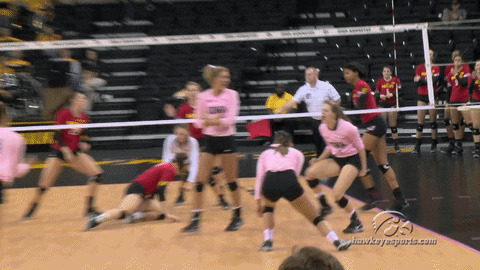Volleyball Glossary

Ace
When a player serves the ball and their opponent is unable to pass it — it either hits the ground immediately, or one member of the opposing team touches it before it hits the ground.
Antenna violation
When one team sends the ball to the other side and it either hits or goes outside of the antennae on the sides of the net.
Block
When a player prevents an opponent’s hit from going over the net.
Defensive specialist
A player who enters the game for the three back-row rotations only. Typically a strong passer, server, and defender. Unlike the libero, the DS can only substitute in for one player per set.
Dig
When a player successfully passes an attack from the opponent, like a hit, for example.
Double-contact
When a player attempts to set a ball, but it is not one clean contact — typically, one of the players’ hands hits the ball first, causing the ball to spin. A new rule change permits double contacts on any of the three touches, whereas historically double contacts were only permitted on the first touch.
Hit
When a player attacks a ball by sending it over the net to the opposing side.
Kill
When a hits a ball and it scores, by either hitting the ground immediately, or hitting the ground after one member of the opposing team touches it.
Libero
The team’s back-row defensive specialist, who wears a different-colored jersey to denote that she can sub in for any other player without it counting against a team’s substitution total. The libero can also sub in for multiple players per set.
Middle blocker
The player who hits and blocks from the middle of the front row. They’re the teams best blockers, although they don’t get as many opportunities for kills as outside hitters and opposites because of their court position.
Net violation
When a player contacts the net with any part of her body, including her jersey, except hair.
Opposite
The player who hits and blocks from the right side of the front row, i.e. usually behind the setter. These players are experts at hitting and blocking.
Out of system
When the team does not get a good first contact so it is more limited on who it can set. Essentially, the team can’t use all of its attackers because the pass isn’t there.
Outside hitter
The player who hits and blocks from the left side of the front row. These stone-cold killers tend to rack up the most hits on a team.
Pancake
When a player dives and digs a ball with only her hand flat on the ground. Typically a play of last resort.
Point
What a team receives when they score by 1) forcing the ball to touch the ground on their opponent’s side of the net or 2) forcing their opponent to hit the ball out of bounds.
Reverse sweep
When a team loses the first two sets, then wins three in a row to claim victory in a best-of-five match.
Serving specialist
A player who subs in for another to serve the ball, and who subs out after their serving run ends. Typically a player with a wicked serve who is also a strong defender.
Set
1) When a player uses their hands to pass the ball, or 2) the unit for scoring a volleyball game. A team wins a set by reaching 25 points (or, in the fifth, aka tiebreaker set, 15 points) first — but they must win by two points, so the set continues until that happens. The first team to win three sets wins the match. Think tennis, but less complicated.
Setter
The player who sets the ball for one of the hitters to attack. The setter is usually the team’s offensive decision-maker. Setters have to be strong defenders, and sometimes are responsible for blocking.
Setter dump
When a setter attacks the ball on the second contact instead of setting another player. This is really effective to keep the other team’s defense guessing.
Tool
When a player hits the ball into the other team’s block on purpose, and then the ball hits the ground, scoring a point for the hitter’s team. The hitter’s goal is to “use” the other team’s block.